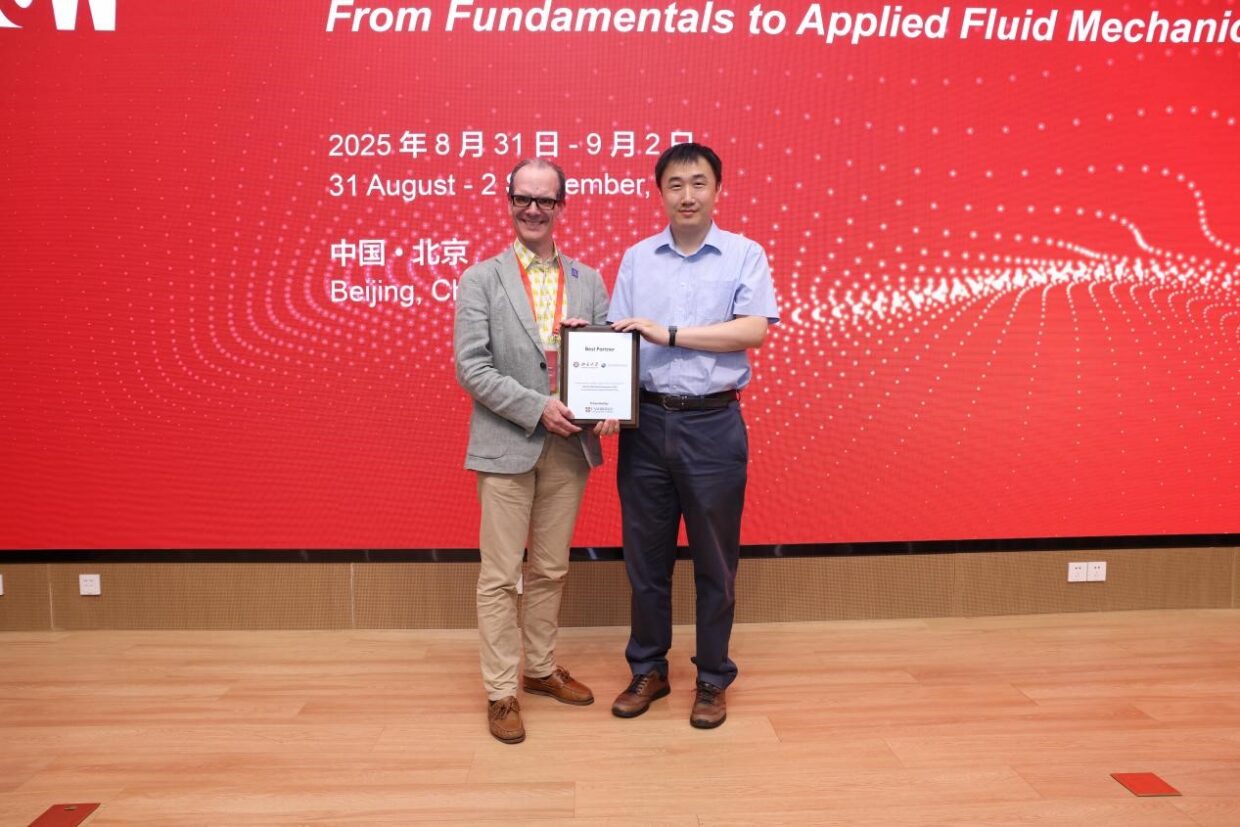Exploring the Frontiers of Fluid Mechanics: Highlights from the JFM/FLOW Symposium China 2025
From August 31 to September 2, 2025, Peking University hosted the JFM/FLOW Symposium China: From Fundamentals to Applications in Fluid Mechanics, a landmark event that brought together global leaders in fluid mechanics research. Jointly organized by the School of Mechanics and Engineering Science at Peking University, the State Key Laboratory for Turbulence and Complex Systems, and Cambridge University Press, the symposium aimed to foster collaboration, share cutting-edge discoveries, and advance the field’s real-world impact.

A Gathering of Global Minds
The symposium officially opened on September 1, welcoming over 160 experts and scholars from prestigious institutions including Peking University, Tsinghua University, the University of Cambridge, Stanford University, the University of Tokyo, and KTH Royal Institute of Technology. The event also reached a broader audience through online livestreams, which garnered more than 34,000 views.
Notable attendees included:
- Prof. Colm-Cille P. Caulfield (University of Cambridge), Editor-in-Chief of Journal of Fluid Mechanics (JFM)
- Prof. Juan G. Santiago (Stanford University), Editor-in-Chief of FLOW
- Prof. Dan Henningson (KTH Royal Institute of Technology)
- Prof. Shu Takagi (University of Tokyo)
- Prof. Cunjing Lv (Tsinghua University)
Opening Remarks and Vision
Professor Yue Yang, Dean of the School of Mechanics and Engineering Science at Peking University, opened the symposium by emphasizing fluid mechanics as a vital bridge between fundamental science and engineering applications. He highlighted its relevance to aerospace, biomedicine, and renewable energy, and expressed hope for deeper interdisciplinary collaboration.
Professor Cunbiao Li, Director of the State Key Laboratory, echoed this sentiment, stressing the importance of connecting theoretical research with practical solutions.


Keynote Insights
The symposium featured a series of compelling keynote lectures, including:
- Prof. Colm-Cille P. Caulfield: Stratified turbulence: climate’s mysterious mixer

- Prof. Lianping Wang (Southern University of Science and Technology): How do we as a community better support JFM?
- Prof. Dan Henningson: Large-scale numerical experiments of unsteady aerodynamic flows
- Mr. James Pan (Cambridge University Press): Fluid Mechanics in Cambridge University Press

[From left to right: Prof. Lianping Wang, Prof. Dan Henningson, Mr. James Pan delivering their keynote speeches]
Spotlight on Research
The afternoon sessions showcased groundbreaking work from other leading researchers:
- Prof. Chunxiao Xu: Transverse curvature effects on characteristics and control of cylindrical turbulent boundary layer
- Prof. Shu Takagi: Eulerian methods for fluid–structure interaction and blood cell flows
- Res. Fellow Zhan Wang: Hydroelastic waves and their applications
- Res. Fellow Jinhang Xie: Energy transfer in geophysical turbulence
- Dr. Anna Simpson: Development of JFM and FLOW in China

[From left to right: Prof. Chunxiao Xu, Prof. Shu Takagi, Res. Fellow Zhan Wang, Res. Fellow Jinhang Xie, Dr. Anna Simpson delivering their keynote speeches]
Similarly to previous years, Editorial board members from FLOW and JFM also held an engaging interactive session, discussing journal scope, peer review processes, and future directions with participants.

[From left to right: Dr. Anna Simpson, Prof. Cunjing Lv, Prof. Xiaojing Zheng, Prof. Shu Takagi]

[From left to right: Dr. Anna Simpson, Prof. Lianping Wang, Prof. Yue Yang, Prof. Dan Henningson, Prof. Colm-Cille P. Caulfield]
The parallel sessions on September 2 featured 29 invited speakers from leading Chinese universities and research institutes, showcasing cutting-edge research across diverse areas of fluid mechanics. The calibre of speakers this year was unmatched compared to previous editions.

[From left to right, top to bottom: Prof. Zhaosheng Yu, Res. Fellow Xiaolei Yang, Prof. Xi Chen, Res. Fellow Benshuai Lv, Prof. Caihong Su, Prof. Zhigang Zhai, Assoc. Prof. Ao Xu, Asst. Prof. Pengyu Lv, Prof. Yang Xu, Prof. Yi Zhou, Assoc. Prof. Zhanqi Tang, Assoc. Prof. Peng Wang, Prof. Shunlin Tang, Res. Fellow Tongbiao Guo, Assoc. Prof. Qi Li — each delivered an invited talk]

[From left to right, top to bottom: Prof. Benlong Wang, Prof. Jian Deng, Prof. Huan Zhang, Res. Fellow Yi Man, Prof. Xuerui Mao, Assoc. Res. Fellow Ziqiang Yang, Prof. Jie Zhang, Res. Fellow Chi Zhu, Prof. Lei Wu, Prof. Tao Tang, Assoc. Prof. Jianzhao Wu, Asst. Prof. Guangzhao Zhou, Res. Fellow Zaiyi Shen, Assoc. Res. Fellow Wen Zhang — each delivered an invited talk]
Strengthening Global Partnerships
At the closing ceremony, Professor Caulfield presented the “Best Partner Award” to the School of Mechanics and Engineering Science at Peking University, recognizing its outstanding contributions and reinforcing the growing collaboration between Chinese institutions and Cambridge University Press.

[Left: Prof. Colm-Cille P. Caulfield, right: Prof. Yue Yang]
Looking Ahead
Founded in the 16th century, Cambridge University Press is the world’s oldest academic publisher, with JFM and FLOW serving as flagship journals in fluid mechanics. While JFM focuses on theoretical, computational, and experimental studies, FLOW emphasizes applied research with real-world impact.
From turbulence modelling to climate dynamics, and from biomedical flows to energy systems, the symposium underscored the central role of fluid mechanics in solving global challenges. As the field continues to evolve, events like the JFM/FLOW Symposium China 2025 will remain crucial in driving innovation and fostering international collaboration.






